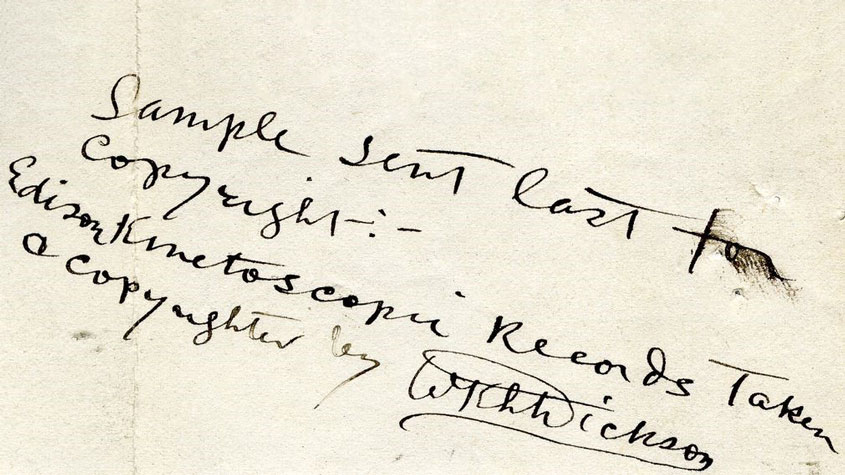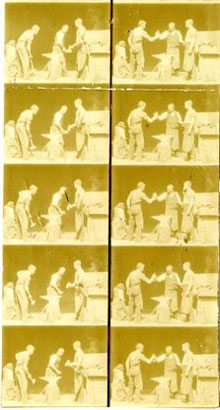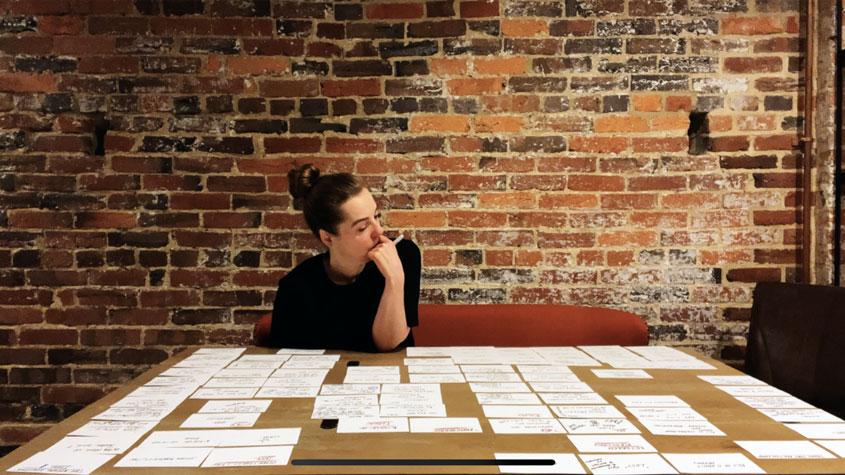By Wendi A. Maloney, writer-editor, Office of Communications, The Library of Congress, Washington, D.C., United States
– republished courtesy of the Library of Congress
The perfectly folded letter opened, and pictures dropped out — 18 small images imprinted in two strips on a single sheet. Three men stand around an anvil, enacting a scene from a blacksmith’s shop.
“I froze,” says Claudy Op den Kamp, the film scholar who extracted the letter from a Library of Congress archival box in Culpeper, Virginia, USA, in the summer of 2022. “I couldn’t grasp what I was holding.” She certainly hadn’t expected the pictures.
Dated Nov. 14, 1893, the letter was signed “W.K.L. Dickson.” She knew him as the head photographer at Thomas Edison’s New Jersey laboratory at a time when Edison was racing against competitors to establish himself as the father of motion pictures — as if, she says, having invented the light bulb and the phonograph wasn’t enough.

Dickson wanted to know the status of a copyright application he’d submitted to the Librarian of Congress, Ainsworth Rand Spofford, several weeks earlier. At the time, Spofford was also head of U.S. copyright operations.
The application was for a motion picture Dickson described only as “Kinetoscopic Records.” Dickson said the pictures contained in his letter were samples from the film. He had recorded them on a new machine perfected in Edison’s lab. The machine could take 40 pictures a second, each an inch (2.54 cms) by three quarters of an inch (1.9cms) in size. Imprinted on film stock and viewed through a kinetoscope — another Edison breakthrough — the images appeared to move. Dickson was making new films daily, he wrote, and he wanted to protect the lab’s work from the competition.
Op den Kamp caught her breath, then cried out. In her hands, she held evidence from the birth of American cinema, a piece of paper that solved a longstanding mystery: What was the first U.S. motion picture ever copyrighted?
For years, scholars had known that an unidentified film registration had been made in 1893. But no one had been able to tie that registration to an actual motion picture title with any kind of certainty — until now.
Mike Mashon, head of the Library’s Moving Image Section, came running from a nearby office. “It was a wonderful moment, it really was,” he says.
To the uninitiated, motion picture copyright might seem an arcane subject. But not to film scholars. For decades, they’ve mined copyright records at the Library — home to the U.S. Copyright Office — to piece together the story of early cinema.
Under U.S. copyright law, registrants have to submit copies of their works when they apply. When Dickson and other early producers registered, they couldn’t have known they were documenting the start of a world-changing industry.
“It only becomes clear in retrospect,” Mashon says. “But it’s from those early efforts that global cinema eventually emerges. Copyright has played an incredibly important role in preserving the record.”
Edison patented an extraordinary 1000-plus inventions in his lifetime and zealously used legal means to protect his achievements. Dickson himself had been registering photographs with Spofford for years. So, it’s not surprising Edison’s lab turned to copyright for its films.

to be copyrighted, the Blacksmith’s scene
by Edison, marking the beginnings of
cinema in the United States.
(Photo: Courtesy of the Library of Congress,
Washington D.C., USA)
Now, we know from Op den Kamp’s research that the first copyrighted motion picture was Edison’s “The Blacksmith Shop,” also known as “The Blacksmith Scene” or “The Blacksmithing Scene.”
The second film copyrighted, also from Edison’s lab, has long been known. Registered on Jan. 9, 1894, and inscribed in the official copyright record book as “Edison Kinetoscopic Record of a Sneeze,” it’s often called “Fred Ott’s Sneeze.”
Ott was an employee in Edison’s lab, and he’s filmed sneezing as part of the lab’s motion picture experimentation. Prints submitted with the registration were transferred from copyright archives to the Library’s collections in the 1940s, and the Library has often displayed the prints and written about the film.
Although Spofford recorded a registration in 1893 as “Edison Kinetoscopic Records” — the same registration Dickson was asking about — neither Dickson’s original letter nor any prints from the film were known to exist. Until the blacksmith pictures dropped onto the table in front of Op den Kamp.
A principal academic in film and intellectual property (IP) at Bournemouth University in the United Kingdom, she was in residence at the Library’s John W. Kluge Center for six months in 2022, to study Spofford’s role in the formation of the Library’s paper print collection — rolls of photographic contact paper the earliest producers submitted to register motion pictures.
Most early films were made on nitrate stock, which is highly flammable and prone to deterioration — the Library didn’t have the capacity to house them safely at the time. Nor did a category exist in copyright law for motion pictures until 1912.
Pioneering producers, starting with Edison, exposed their nitrate film negatives on rolls of photographic contact paper to register them, mostly as photographs, a category established in 1865.
The Library has about 6,500 paper prints — now including the blacksmith images — more than any other institution in the world by far. They’re a goldmine for researchers, because most nitrate films no longer exist.
That is not the case, however, for “The Blacksmith Shop.” Business magnate Henry Ford, Edison’s close friend, had a copy, and it survived. The Museum of Modern Art later preserved it.
“The idea that Ford had that copy, that Edison perhaps gave it to him or sent it to him, shows that Edison deemed it special,” Op den Kamp says.
It even made its way onto the Library’s National Film Registry in 1995. According to the Registry, it features the first screen actors in history, one of whom is allegedly John Ott, brother of Fred, and another Edison employee. Shown to audiences in Brooklyn, New York, on May 9, 1893, the film is also considered the first of more than a few feet to be exhibited publicly. “It shows living subjects portrayed in a manner to excite wonderment,” a Brooklyn newspaper reported the following day.

For Op den Kamp, connecting “Edison Kinetoscopic Records” from the copyright record book to “The Blacksmith Shop” didn’t involve dangers beyond a little dust. But her quest did have an almost Indiana Jones quality to it. By the time she opened Dickson’s letter, she’d consulted around 30 staff experts, current and retired; used five reading rooms; and become intimately familiar with evolving copyright archival practices. All this led her to request five pallets from storage from the Rare Book and Special Collections Division, each containing 50 boxes, each associated with 2,000 registrations. And inside one of the boxes, she found the letter.
“It sat exactly where it was supposed to sit,” Op den Kamp says. She just had to figure out its path over the past 129 years.
Film scholars, she says, had long assumed “Kinetoscopic Records” implied multiple motion pictures. “The Blacksmith Shop” was strongly suspected to be among them. Other contenders included Edison’s “Carmencita,” his “Caicedo” and his “Serpentine Dance” films.
“We now know that ‘records’ meant the multiple images in strips,” she says, as in the sample in Dickson’s letter.
“In some ways,” Mashon says, “the letter Claudy found is the Big Bang. Everything sort of flows from that. It was exciting to be part of that discovery.”



